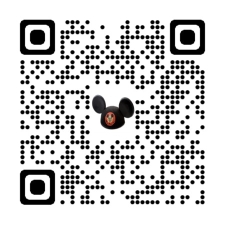
Flying Saucers are now a reality based in a "Space Station" in Disneyland's Tomorrowland. Here the guests may climb aboard his own craft, fasten his safety belt and actually take off in free flight and guide his own space ship.Showing more ambition than practicality Disneyland debuted it's unique space-age bumper car ride in mid 1961. UFOs had been a hot topic throughout the fifties when sightings headlined news papers and bug-eyed Martians invaded America's drive-in movie screens thus the time seemed right for flying saucers to invade Disneyland.The parks promotional literature played up the attraction fly your own flying saucer at the space terminal touted the attraction poster each guest pilots his own ship in free flight announced the 1961 souvenir book.Space travel at a space station captioned the 1962 book for a Flying Saucers photo.Choose your flight pattern and away you go exhorted the 1965 book all intriguing descriptions to be sure.
The Bob Gurr designed saucers were small one seat hovercraft 6 feet in diameter.In reality Disneyland's Flying Saucers probably should have been called the hover saucers operating in a circular open-air platform that covered a third of an acre next to the Rocket To the Moon attraction. The saucers got airborne when they were lifted up by high powered jets of air generated by large motors under the platform when they hovered successfully the 64 saucers in 2 fleets of 32 could lift a few inches off the ground. Though they had no controls only handles inside their cockpits. The saucers could be steered independently by guests who only had to lean to dip their saucers in any direction even into other saucers for some bumper bashing.
The Flying Saucers ride uses a big, blue oval, bisected into two halves, each with thousands of round air valves, Each half has a movable arm. There are four fleets of 16 saucers. Unlike other “batch load’ attractions, this one loads efficiently.Loading and unloading takes place in a neat cluster of two rows of saucers. Sit down on your individual Space Age pod. Hold on to the round handles on either side of your seat.
As the ride cycle begins, a giant arm slowly swings away from the loading area, releasing your group of saucers. Air valves directly below your saucer lift it up.Tilt your body to make your saucer scoot across the ride surface. Wherever you go, your saucer actuates air valves as you pass over them. All the lift comes from below. Your saucer has no moving parts—or, more accurately, you’re the only moving part of your vehicle. You can go remarkably fast.Maneuvering your saucer is easy and intuitive if you’re sitting alone. (When two children share a seat, they need to cooperate.)
Bump into other guests—surprise them from behind! This ride has been called “the bumper cars of the future,” but that’s not entirely apt. Earthbound bumper cars collide with a jarring thump. But these airborne bumping saucers bounce off each other delightfully when they collide. It’s a different sensation.
Unfortunately persistent problems with the air jets led to lots of ground time for the e-ticket attraction.Body weight was also an issue small guests couldn't get their sauces to dip anywhere while some larger guests couldn't even get off the ground other guests occasionally turn their saucers completely over risking a crash. Too often guests couldn't go anywhere because the whole system would shut itself down. Some 5 million pilots gave the saucers a test flight but after 5 years of headaches and extremely loud noise Disney designers finally ground in the troublesome ride in 1966 remodeled the whole area as a Tomorrowland stage in 1967.The flying saucers attraction was one of the worst maintenance headaches at Disneyland. The ride was built by the Arrow Company. The flying saucers area was 16,000 square foot with 2 sections each section with 32 saucers: 16 flying while 16 were being loaded. Flight time was 3 minutes.
The Flying Saucers were designed by: National Research Associates, Inc. NRA was founded in 1958 by Mel Beardsley. An early use for a similar single-seater but not self-propelled, being inflated by blowers below the deck was a ride at Disneyland. Disney licensed the technology from NRA. The name GEM is derived from the acronym for ground-effects machine.





